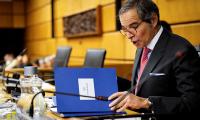LAHORE: Central bank's foreign exchange reserves have slumped to their lowest since June 30, 2021 and are too far from enough to finance the import bill of this country for the next three months.
The government had built these reserves on borrowed money and thus were not sustainable to begin with.
According to the central bank data the foreign exchange reserves were down at $9.76 billion on June 30, 2017-18. The reserves further declined to $7.28 billion at the end of next fiscal year. The reserves increased to $12.13 billion by the end of fiscal year 2019-20. The reserves further jumped to $17.84 billion by June 30, 2020-21. The growth in reserves continued and in August 2021 they increased to $20.07 billion.
The imports during this period were compressed to improve the current account position. All the reserves were accumulated by interest-based deposits from China ($2.5 billion), Saudi Arabia ($3 billion of which $1 billion were withdrawn), UAE ($2 billion), and IMF ($1 billion).
By August 2021 the imports were more than two times the exports. The foreign exchange reserves started depleting and were rebuilt with foreign loans. In September 2021 the reserves first depleted to $19.25 billion and then to $17.84 billion. In October 2021 the country’s dollar cache eased to $17.19 billion and in November 2021 to $15.96 billion. The government again borrowed to increase them to $18 billion. The dollars declined to $17.68 billion in December 2021 and to $16.60 billion in January 2022. They depleted to $16.38 billion in February this year.
However, reserves slumped by a massive $4.36 billion to $12.04 billion by March 25. On March 4, 2022 they fell to $16.21 billion, on March 11 to $15.83, on March 18 to $14.96 billion, and on March 25 they finally settled down to $12.04 billion.
After June 2021, Pakistan received $2 billion from the IMF after the lender of the last resort raised the loan limit for developing countries. We later received $1.2 billion tranche from the IMF programme we are in. It later received loans around $1.5 billion from World Bank, Asian Development Bank, and Islamic Development Bank. All these foreign inflows have been consumed. Loans from friendly countries are not cheap as the markups are really high, while loans from the World Bank and Islamic Development Bank are concessional. We will be forced to obtain more loans to remain liquid and service our past loans.
The pressure on reserves has accelerated the devaluation of the rupee, which is trading above Rs184.5 against the dollar. The inflation in March stood at 12.27 percent. A low-valued rupee and high inflation will force the central bank to jack up its policy rates that are still twice as much higher than the regional average. The central bank governor in his last monetary policy address had hinted at calling a monetary policy board meeting in April if things went out of hand. He may convene the meeting soon, given the gravity of the situation.
By the way the labour wages in Pakistan are now at par with Bangladesh. At a minimum wage of Rs20,000 the wage in dollars comes at $108/month, same as in Bangladesh. Wages in India, China and Vietnam -our competitors in textiles are 30-60 percent higher.
The Turkish Consul General, Cemal Sangu paid a visit to Dawlance’s Head Office in Karachi, where he met the CEO...
This representational image shows Gold bars. — AFP/FileKARACHI: Gold prices rose by Rs3,700 per tola on Thursday in...
PCJCCI logo can be seen on a computer screen, image taken on November 5, 2024. — TheNews/AquibAliLAHORE: The...
Participants listen to speeches during the United Nations Climate Change Conference in Baku on November 13, 2024. —...
The representational image shows a laptop in use. — Unsplash/FileLAHORE: Effective trade policies require consistent...
National Assembly’s Standing Committee members and IMC officials posing for a photo. — IMC website/fileKARACHI:...







